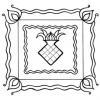Rangoli is present in different forms all over India; but is known by different names in different parts of the country. Rangoli art is known by the following names:
• Alpana (West Bengal)
• Aripan (Bihar)
• Aipan (Uttarakhand)
• Jhoti or Chita (Orissa)
• Kolam (Tamil Nadu)
• Muggu (Andhra Pradesh)
• Madana (Rajasthan)
• Rangoli (Gujarat, Karnataka and Maharashtra)
• Chowkpurana (Uttar Pradesh)
In fact each state of India has its own style of rangoli. Design depictions also vary as they reflect traditions, folklore and practices that are unique to each area. Rangoli is traditionally created by women in almost all Hindu households. No formal training is really necessary for learning this art. This art is typically transferred from generation to generation and from friend to friend, thus keeping the tradition alive.
Over the years, tradition has made room for modern variations that have added some flair to this beautiful art. Rangoli thus is rooted in tradition and yet thrives in this present era in a modern form.







